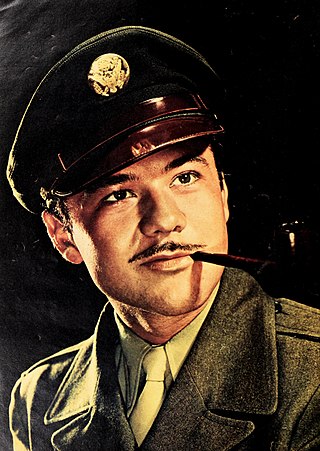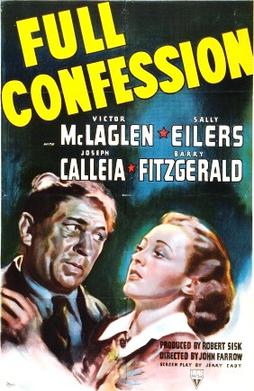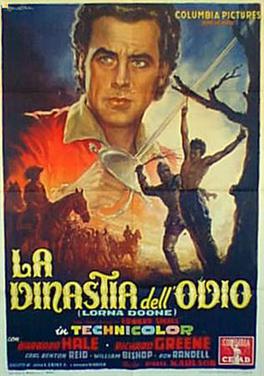
Jon Hall was an American film actor known for playing a variety of adventurous roles, as in 1937's The Hurricane, and later when contracted to Universal Pictures, including Invisible Agent and The Invisible Man's Revenge and six films he made with Maria Montez. He was also known to 1950s fans as the creator and star of the Ramar of the Jungle television series which ran from 1952 to 1954. Hall directed and starred in two 1960s sci-fi films in his later years, The Beach Girls and the Monster (1965) and The Navy vs. the Night Monsters (1966).

Charles John "Tim" Holt III was an American actor. He was a popular Western star during the 1940s and early 1950s, appearing in forty-six B westerns released by RKO Pictures.

Turhan Bey was an Austrian-born actor of Turkish and Czech-Jewish origins. Active in Hollywood from 1941 to 1953, he was dubbed "The Turkish Delight" by his fans. After his return to Austria, he pursued careers as a photographer and stage director. Returning to Hollywood after a 40-year hiatus, he made several guest appearances in 1990s television series including SeaQuest DSV, Murder, She Wrote and Babylon 5 as well as a number of films. After retiring, he appeared in a number of documentaries, including a German-language documentary on his life.
Edward Small was an American film producer from the late 1920s through 1970, who was enormously prolific over a 50-year career. He is best known for the movies The Count of Monte Cristo (1934), The Man in the Iron Mask (1939), The Corsican Brothers (1941), Brewster's Millions (1945), Raw Deal (1948), Black Magic (1949), Witness for the Prosecution (1957) and Solomon and Sheba (1959).
Norman Krasna was an American screenwriter, playwright, producer, and film director who penned screwball comedies centered on a case of mistaken identity. Krasna directed three films during a forty-year career in Hollywood. He garnered four Academy Award screenwriting nominations, winning once for 1943's Princess O'Rourke, which he also directed.

Adventures of Don Juan is a 1948 American Technicolor swashbuckling adventure romance film directed by Vincent Sherman and starring Errol Flynn and Viveca Lindfors, with Robert Douglas, Alan Hale, Ann Rutherford, and Robert Warwick. Also in the cast are Barbara Bates, Raymond Burr, and Mary Stuart. The film was distributed by Warner Bros. and produced by Jerry Wald. The screenplay by George Oppenheimer and Harry Kurnitz, based on a story by Herbert Dalmas, has uncredited contributions by William Faulkner and Robert Florey.

Sailor's Lady, also known as Sweetheart of Turret One, is a 1940 film directed by Allan Dwan and starring Nancy Kelly and Jon Hall. The supporting cast includes Joan Davis, Dana Andrews, and Buster Crabbe. Football player Amby Schindler had an uncredited appearance in this motion picture after portraying one of The Winkies in The Wizard of Oz (1939).

The film appearances of movie actor Errol Flynn (1909–1959) are listed here, including his short films and one unfinished feature.

Two Years Before the Mast is a 1946 American historical adventure film directed by John Farrow and starring Alan Ladd, Brian Donlevy, William Bendix, and Barry Fitzgerald. It is based on Richard Henry Dana Jr.'s travel book of the same name and was produced and distributed by Paramount Pictures.
Seton Ingersoll Miller was an American screenwriter and producer. During his career, he worked with film directors such as Howard Hawks and Michael Curtiz. Miller received two Oscar nominations and won once for Best Screenplay for the 1941 fantasy romantic comedy film, Here Comes Mr. Jordan, along with Sidney Buchman.

King of the Khyber Rifles is a 1953 adventure film directed by Henry King and starring Tyrone Power and Terry Moore. The film shares its title but little else with the novel King of the Khyber Rifles (1916) by Talbot Mundy. This novel was also the basis for John Ford's The Black Watch (1929). The Khyber Pass scenes were shot in the Alabama Hills, Lone Pine, California. Released by 20th Century Fox, the film was one of the first shot in Technicolor CinemaScope.

Full Confession is a 1939 United States proto film-noir, crime drama film made by RKO Radio Pictures. It was directed by John Farrow from an adaptation by Jerome Cady of Leo Birinski's story. The film stars Victor McLaglen, Sally Eilers, Barry Fitzgerald and Joseph Calleia.

Valentino is a 1951 American biographical film directed by Lewis Allen and starring Eleanor Parker.

Miss Susie Slagle's is a 1946 American drama film directed by John Berry. It was based on the popular novel by Augusta Tucker. The film was Berry's directorial debut and first starring role for Joan Caulfield.

Lorna Doone is a 1951 American adventure film directed by Phil Karlson and starring Barbara Hale and Richard Greene. It is an adaptation of the 1869 novel Lorna Doone by R. D. Blackmore, set in the English West Country during the 17th century.

Kit Carson is a 1940 Western film directed by George B. Seitz and starring Jon Hall as Kit Carson, Lynn Bari as Delores Murphy, and Dana Andrews as Captain John C. Frémont. This picture was filmed on location at Cayente (Kayenta), Arizona and was one of the early films to use Monument Valley as a backdrop. The supporting cast features Ward Bond as a character named "Ape", future Lone Ranger Clayton Moore without his mask, and Raymond Hatton as Jim Bridger.
Victory is a 1940 American adventure film directed by John Cromwell and starring Fredric March, Cedric Hardwicke and Betty Field. It was based on the popular 1915 novel by Joseph Conrad. On the eve of the American entry into World War II, Conrad's story of a hermit on an island invaded by thugs was refashioned into a call for intervention in the war in Europe at the height of American isolationism.

The Big Guy is a 1939 American drama crime film directed by Arthur Lubin starring Victor McLaglen and Jackie Cooper.

Who Killed Aunt Maggie? is a 1940 American mystery film directed by Arthur Lubin and starring John Hubbard, Wendy Barrie and Mona Barrie. It was produced and distributed by Republic Pictures.

Rio is a 1939 American crime film directed by John Brahm and starring Basil Rathbone and Victor McLaglen. The film's title sequence doesn't credit a producer.
















